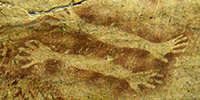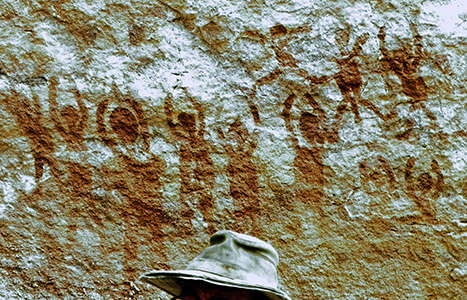Back to Don's Maps
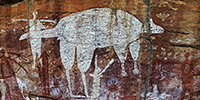 Back to Australian rock art and other Oz sites
Back to Australian rock art and other Oz sites Pine Tree Creek, Tied Up Wrist and Wallaroo Galleries - Aboriginal Rock Art sites in Northern Queensland

Photo: © Leo Dubal
The excellent photographs of Pine Tree Creek, Tied Up Wrist and Wallaroo Galleries Aboriginal Rock Art site on this page are from Leo Dubal, www.archaeometry.org
The rock art of Pine Tree Creek, Tied Up Wrist and Wallaroo Galleries consists of paintings of kangaroos and wallabies, eels, people dancing, and Quinkan figures, and hand stencils of two hands at each end of a wrist.
Pine Tree Creek - Tied Wrist Gallery
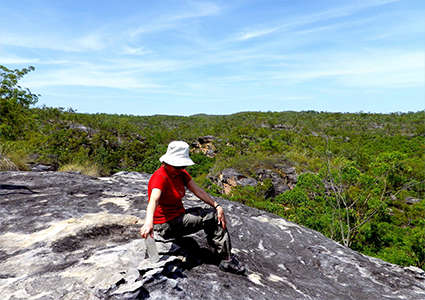
On the rise above the valley of Pine Tree Creek, with a view over the surrounding countryside.
Photo: © Leo Dubal
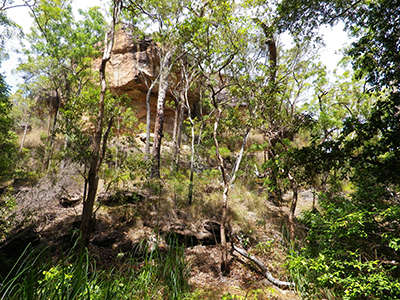
It was a steep climb up to Tied Wrist Gallery.
Photo: © Leo Dubal
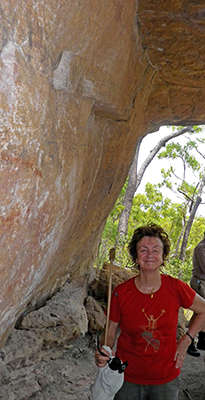
Tied Wrist Gallery. An overhang protects the paintings from the weather.
Photo: © Leo Dubal
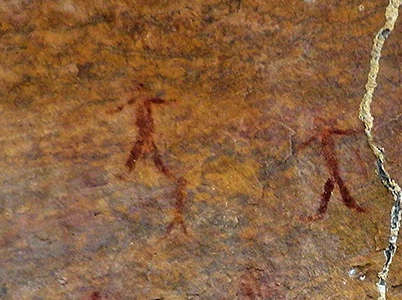
Stick figures completed in red ochre.
Photo: © Leo Dubal
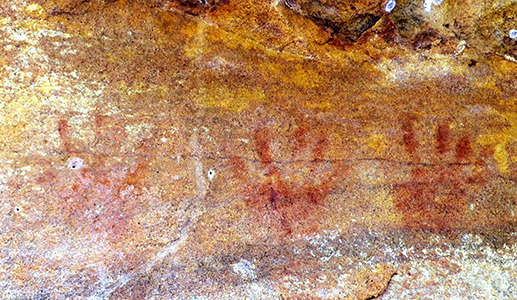
Three positive hand prints in red ochre.
Photo: © Leo Dubal
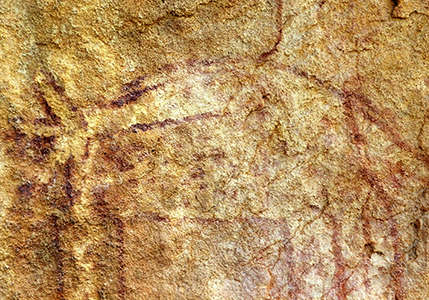
What may be an arm, outlined in dark red ochre.
Photo: © Leo Dubal

The complete figure.
Photo: © Leo Dubal
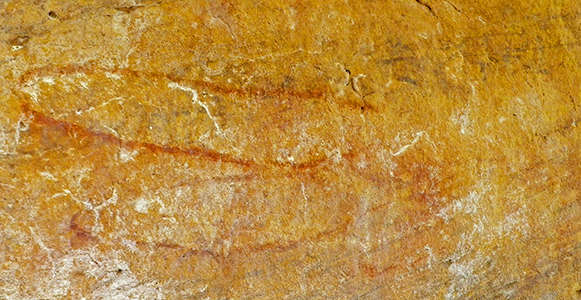
Enigmatic shapes in red ochre.
Photo: © Leo Dubal
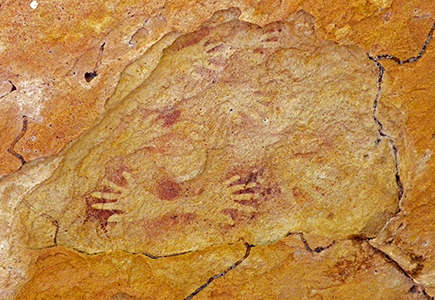
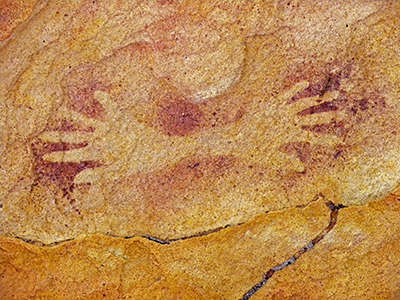
These hands have been purposely stencilled so that they appear to come from the same wrist.
Photo: © Leo Dubal
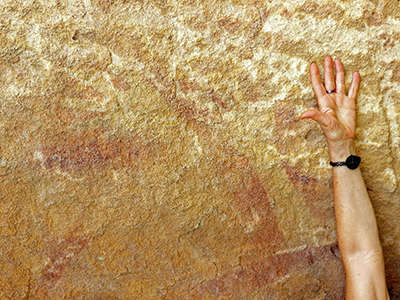
This stencilled hand and forearm has faded with time.
Photo: © Leo Dubal
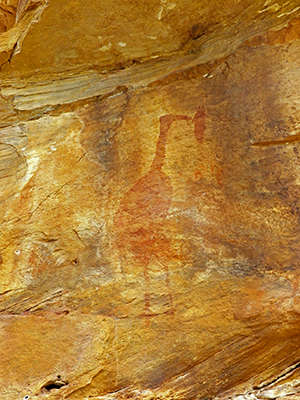
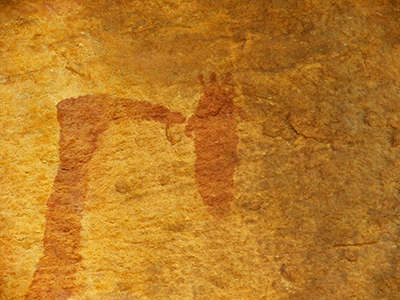
Wading bird, possibly a black necked stork, Ephippiorhynchus asiaticus, eating a catfish.
Photo: © Leo Dubal
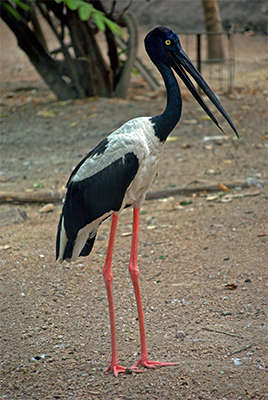
Black necked stork, Ephippiorhynchus asiaticus.
The Black-necked Stork, Ephippiorhynchus asiaticus, is a tall long-necked wading bird in the stork family. It is a resident species across South and Southeast Asia with a disjunct population in Australia. It lives in wetland habitats to forage for a wide range of animal prey. Adult birds of both sexes have a heavy bill and are patterned in white and glossy blacks, but the sexes differ in the colour of the iris. In Australia, it is sometimes called a Jabiru although that name refers to a stork species found in the Americas. It is one of the few storks that is strongly territorial when feeding.
Photo: © Joshua Singh
Permission: Creative Commons Attribution 2.0 Generic license
Text: Adapted from Wikipedia
Wallaroo Galleries
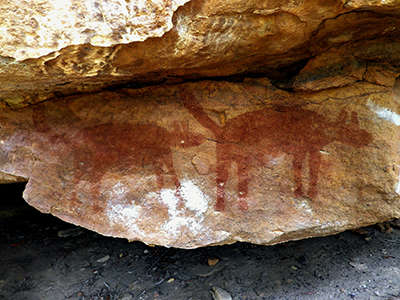
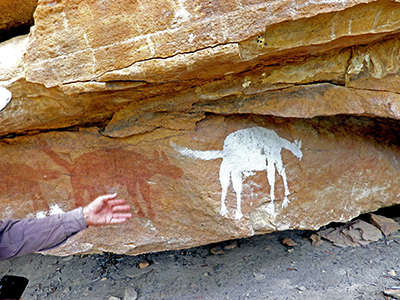
Two red ochre dingos under an overhang, and a white wallaroo.
Photo: © Leo Dubal
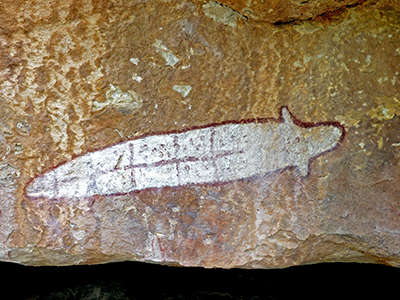
An eel or an eel-tail catfish.
Photo: © Leo Dubal
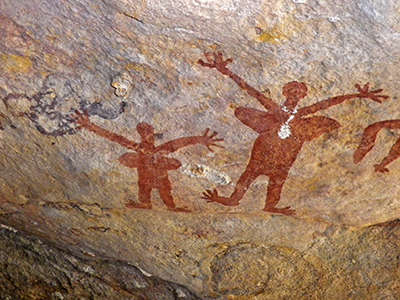
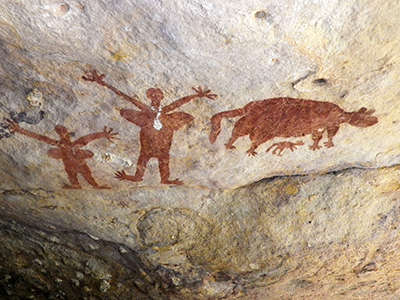
A frieze of two women and a heavy set marsupial with young.
Photo: © Leo Dubal

Woman wearing a pendant from the frieze above. No shoulders are indicated, the arms spring from the neck, and the breasts are spread wide, as is the norm in this sort of representation.
Photo: © Leo Dubal
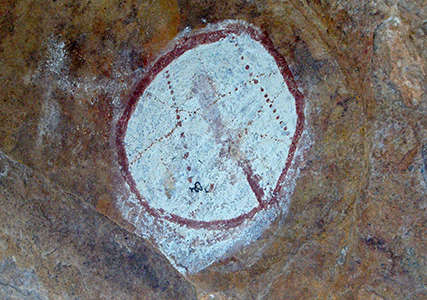
An unusual sign, consisting of a red ochre circle, infilled in white, with red ochre dots as chords across the circle.
Photo: © Leo Dubal

Frieze at Wallaroo Galleries. Note in particular the long red, uneven 'rope' apparently attached to the right leg of the female figure.
Photo: © Leo Dubal

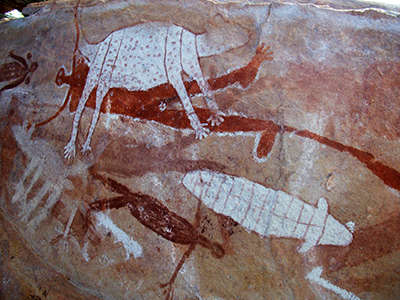
Two views of part of the frieze.
Here can be seen the woman with the rope, overlying this figure is a wallaroo outlined in red ochre, infilled in white ochre, and sectioned and dotted with red ochre.
Below these important figures are a white ochre dingo or wallaroo, a woman lying horizontally in dark red ochre, and an eel-tailed catfish.
Photo: © Leo Dubal
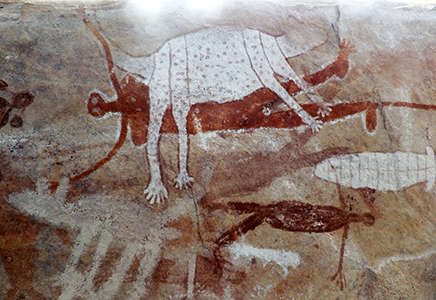
In this close up of the woman with the rope, it can be seen that the figure was outlined in white ochre, infilled in red ochre, then large dots were added for the eyes, and white dots were placed on the body. One foot is shown with four toes, the other has none.
It should be noted that the woman's long, thin, impossibly curved arms have been redone at some stage, since one overlies the later wallaroo image. Careful examination will reveal that part of the woman's body shows through the otherwise opaque white ochre of the wallaroo.
Photo: © Leo Dubal

The long uneven 'rope' apparently attached to the right leg of the woman overpainted by a wallaroo is difficult to interpret.
It is not really part of the woman, since it is not outlined in white ochre, as her figure is.
The catfish has been outlined in red ochre, infilled in white, then lines in red ochre have been drawn, giving the effect of a skeleton showing through the figure.
At the bottom right is what appears to be the legs and body of a human, shown horizontally, with a white ochre mark attached to the body but going vertically up the rock.
Photo: © Leo Dubal

Spirit figure, of indeterminate sex. The image is oriented horizontally on the panel, and has been rotated for this view.
It has been executed in dark red ochre, there are four fingers on each hand, white ochre dots are placed on part of the image.
There are curious objects attached to the head, looking to western eyes something like a woman's pigtails, but they are certainly something else, perhaps ornaments of some kind.
There is the suggestion of eyes and a nose.
Photo: © Leo Dubal

A panoramic picture of a large part of another panel.
Photo: © Leo Dubal
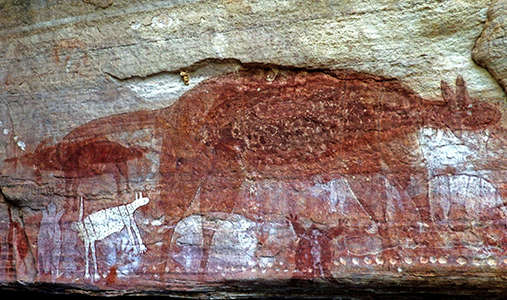
Large wallaroo, with cupules dug into the base of the panel in a long continuous line.
Photo: © Leo Dubal
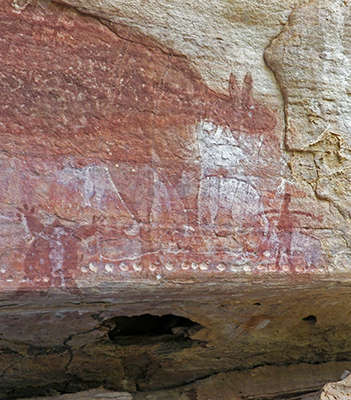
Echidna, wallaroo, and human. There are other images in white ochre which are hard to decipher.
Photo: © Leo Dubal
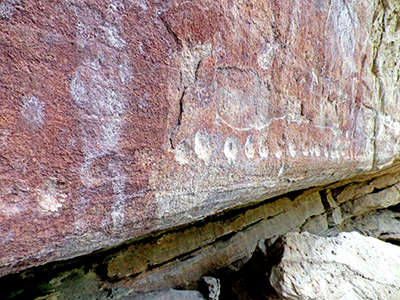
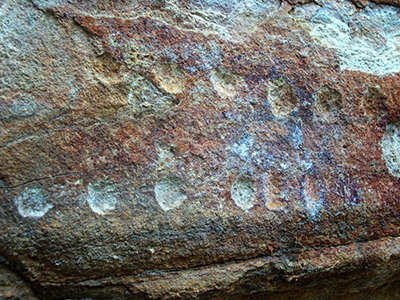
Close ups of some of the cupules. The bottom row in the image on the right appears to be fresh, or perhaps painted in white ochre, but the row above has an older, yellowish patina to it.
Photo: © Leo Dubal

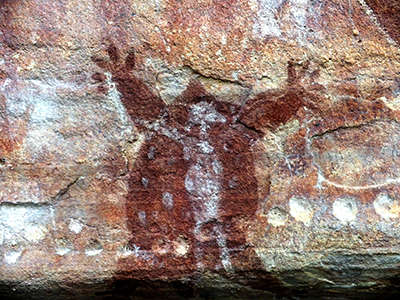
Echidna. Note the cupules, some of which predate the painting, others have been either added later or have been scraped out since.
The echidna may have spiritual significance, since it has had white dots added to it, and a Quinkan figure has been painted on top of it.
Photo: © Leo Dubal
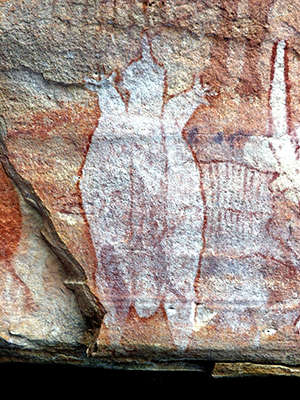
Echidna. The figure is outlined in red ochre, and infilled in white ochre.
Photo: © Leo Dubal
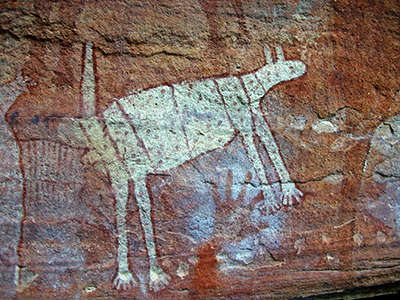
Wallaroo. This figure has been outlined in red ochre, infilled in white, and has been further subdivided with red ochre, and with red dots added to the body of the figure.
On the left is a design similar to a net or basket.
Photo: © Leo Dubal
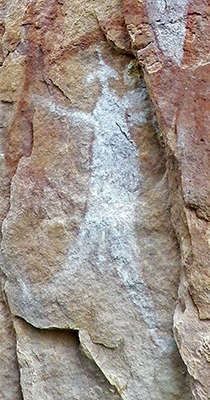
Male Quinkan figure, on its own small panel. It has been outlined in dark red ochre, and then infilled in white ochre.
The tall skinny Quinkan figures are said to be 'good' spirits, while the squat ones with knobbly knees, arms and other parts are 'bad' (Harding, 2002)
Photo: © Leo Dubal
Some observers have wondered whether the strange shape of the head of the Quinkan figures has something to do with hallucinogenic mushrooms. This is unlikely, as the following quote from http://aiprinc.org/aborig.asp shows:
Pituri, intoxicant
Until Europeans arrived, the Aborigines used few drugs. The main one was pituri from the shrub Duboisia hopwoodii. The active ingredient is nicotine, the same alkaloid as in tobacco. 'Pituri' is also used more broadly to include wild tobacco weed. The chemistry of pituri differs widely. In the Northern Territory, the drug is actually non-nicotine, four times more toxic than nicotine. Aborigines there prefer tobacco weed.
Aborigines used pituri to inspire mirth, to increase stamina and courage before warfare or firewalks. Pituri can induce trances, thus accessing the Dreamtime, that is psychic and mystical experiences. Nicotine is also commonly used in American shamanism.
Pituri also refers to the dried leaves and stems of the shrub. Aborigines smoke "quid", a mixture of leaves with ash from the acacia bush, thus increasing drug potency. Leaves are placed behind the ear, or on other body parts. Nicotine is absorbed through the skin. Nicotine in quid -three times more concentrated than in cigarettes - produces stupor and catalepsy, a trancelike pain-free state.
Pituri is hoarded and the shrub localities kept secret. It grows over much of Western Queensland, Eastern Northern Territory and Northwestern NSW, where it was widely traded.
Pituri can induce trances, thus accessing the Dreamtime, that is, psychic and mystical experiences.
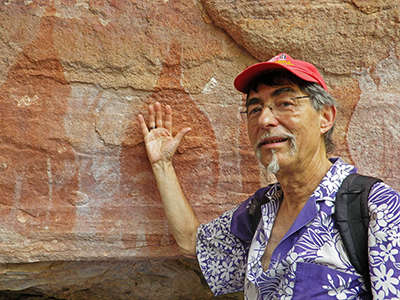
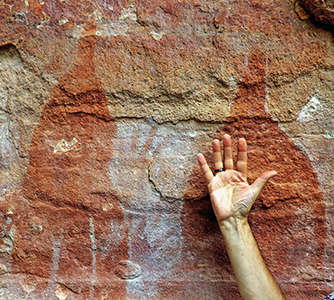
Hand for scale on the heads of two echidna. Between the red ochre echidna heads, not outlined, are at least two negative hand prints in white ochre.
Photo: © Leo Dubal
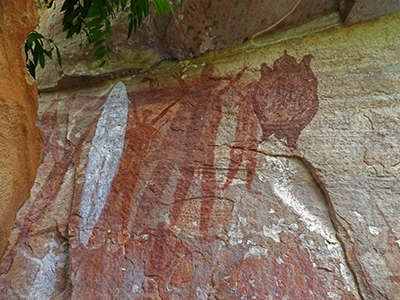
This is a complex panel, including a catfish in white ochre, several human figures, both male and female, and what appears to be a very globular echidna.
At the bottom left of the image is a Quinkan figure in white ochre, outlined in red.
Photo: © Leo Dubal
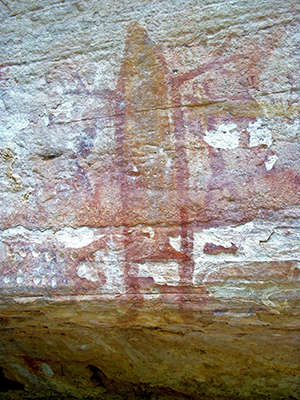
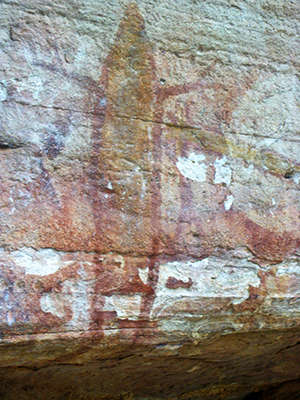
This is an enigmatic figure, a rectangle with what appear to be fins at the point where the rectangle tapers to a point, and with what may be legs curving under the overhang at the other end.
The fins, however, end in three fingers, and may represent the arms of a spirit figure. It has been infilled in a mustard coloured ochre.
It is altogether a very strange image, very hard to interpret.
Photo: © Leo Dubal
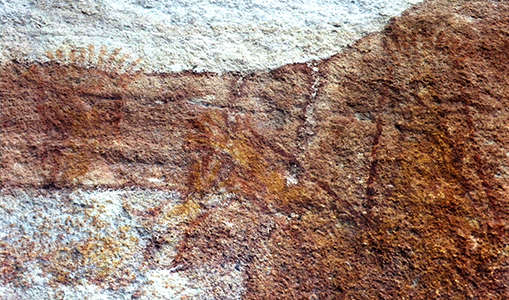
This may represent three spirit figures with rayed head-dresses, or perhaps three yam figures.
Photo: © Leo Dubal
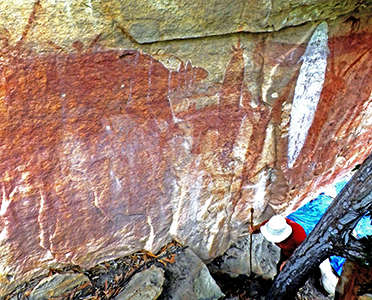
The gallery is at two different levels.
Photo: © Leo Dubal
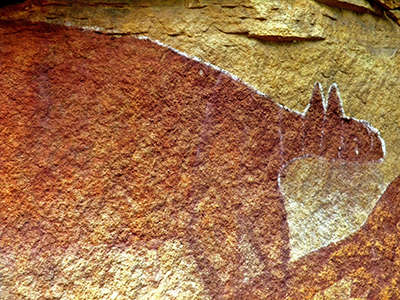
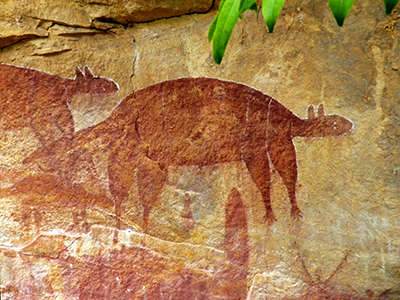
Head and forequarters of a wallaroo, and another in front of it. Note that the front and hind legs are almost the same size and length, which is not the way they are in reality.
Photo: © Leo Dubal
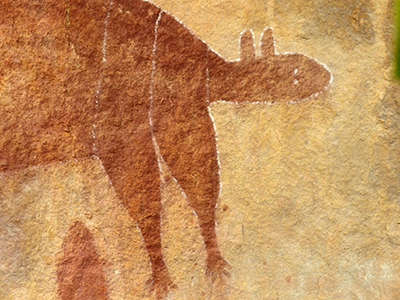
Close up of the right hand wallaroo.
Photo: © Leo Dubal
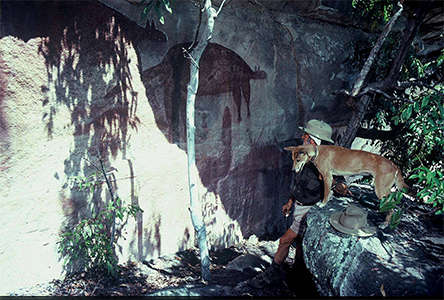
Percy Trezise and his dingo Lasca at Wallaroo Gallery, circa 1982.
Photo: © https://www.facebook.com/JowalbinnaBushCamp?filter=1

The right hand wallaroo has the front legs sectioned off by white ochre, while beneath it is what may have been a catfish, with a human figure with arms raised emerges from a solid band of red ochre.
Photo: © Leo Dubal
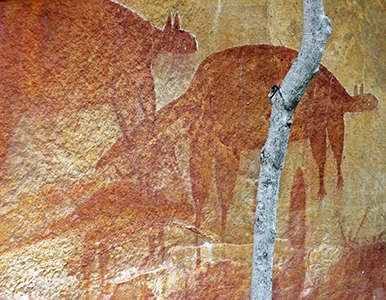
Another view of this section of the panel, showing a smaller wallaroo below the larger pair.
Photo: © Leo Dubal
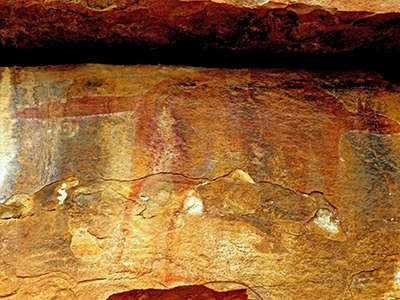
This is what appears to be a much older painting of a wallaroo, outlined in white ochre and infilled in red ochre. It is protected by a rock overhang.
Photo: © Leo Dubal
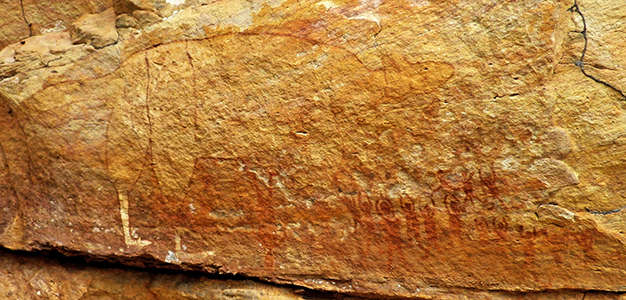
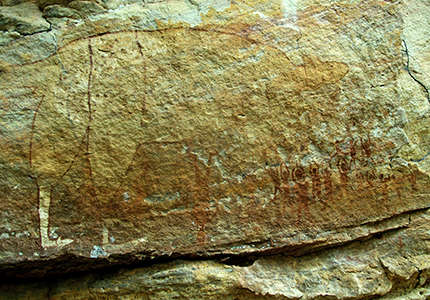
This is an important panel, showing an apparently old image of a wallaroo, outlined in dark red ochre, and infilled in mustard coloured ochre. Below it are a group of much smaller near-identical human figures, shown with proportionately large heads, apparently dancing.
Three quite different human forms, also dancing, have been painted above this large dance or corroboree group.
On the left of these figures is another larger human figure, shown upside down.
Photo: © Leo Dubal
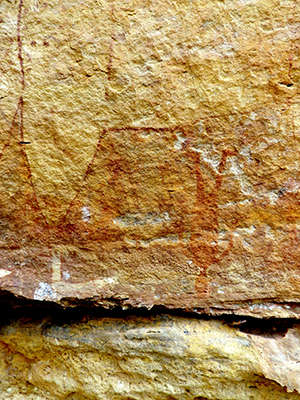
Close up of the inverted human figure.
Photo: © Leo Dubal
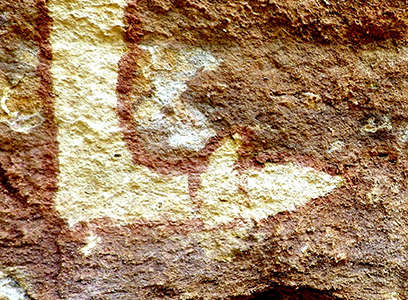
Close up of the wallaroo foot.
Photo: © Leo Dubal
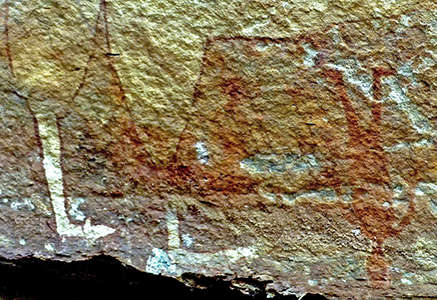
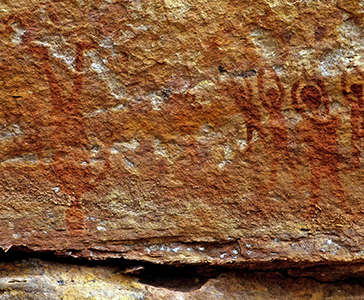
Close up of the back feet of the wallaroo, as well as the inverted human form and some of the dancing group.
Photo: © Leo Dubal
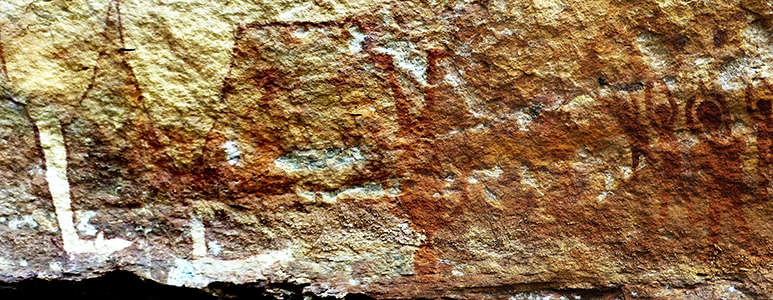
The two photographs above stitched together.
Photo: © Leo Dubal
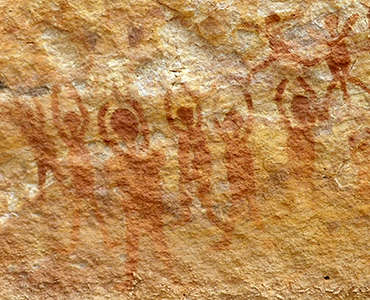
Other views of the dancing figures.
Photo: © Leo Dubal
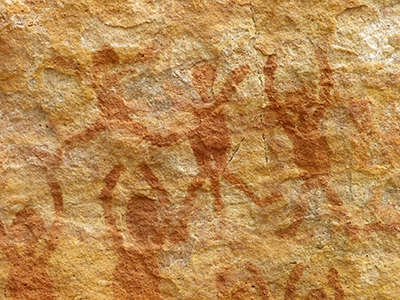
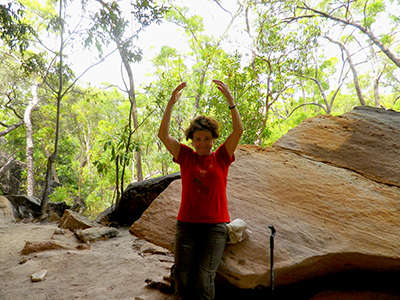
Mme Dubal demonstrating the dancing method!
Photo: © Leo Dubal
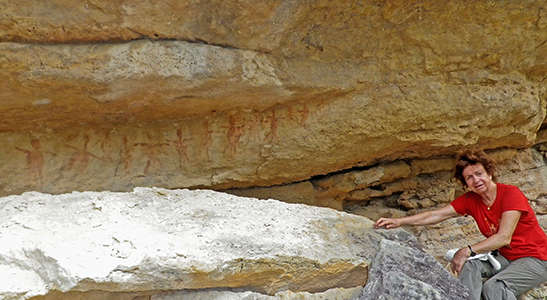
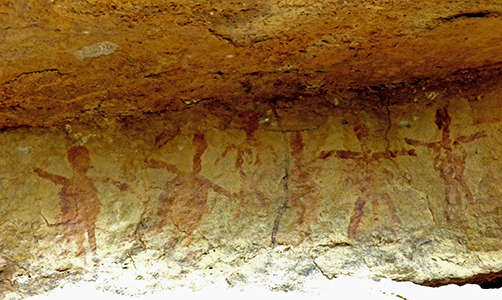
These dancing figures appear older, and are protected beneath an overhang.
Photo: © Leo Dubal
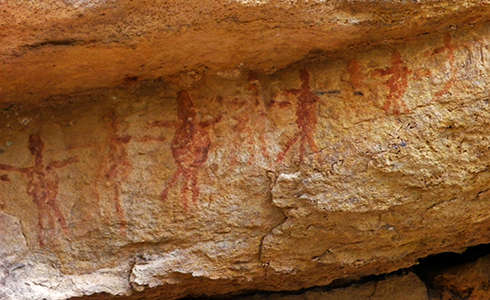
Close up of the right hand end of the frieze of dancing figures.
Photo: © Leo Dubal
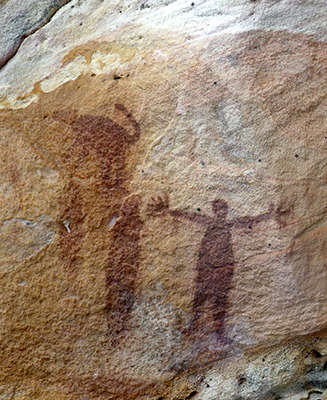
Human on the right, drawn in dark red ochre, with very large fingers. There is an indeterminate figure in the middle, with what looks like a dingo at the top right.
Photo: © Leo Dubal
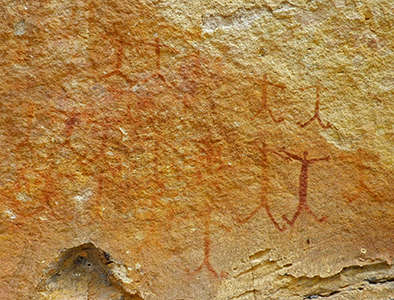
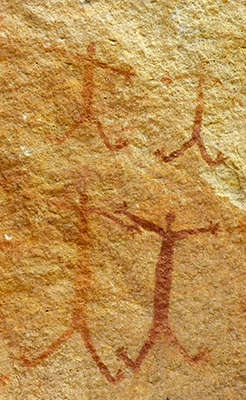
Dancing stick figures.
Photo: © Leo Dubal
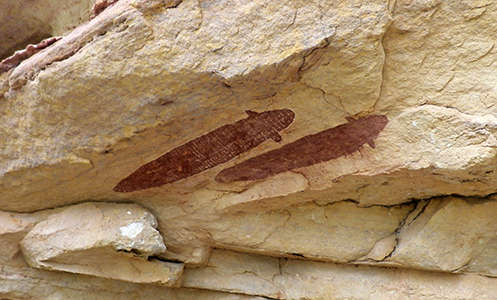
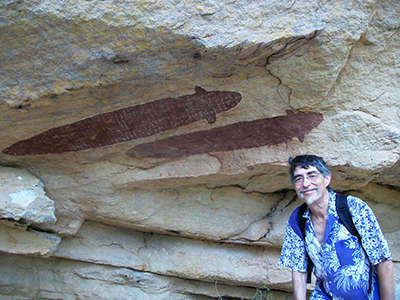
Eel-tailed catfish.
Photo: © Leo Dubal
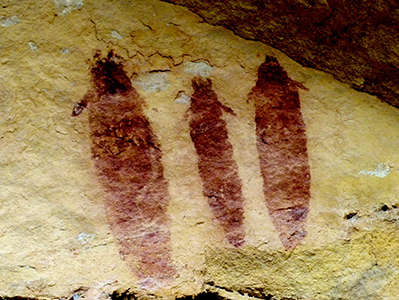
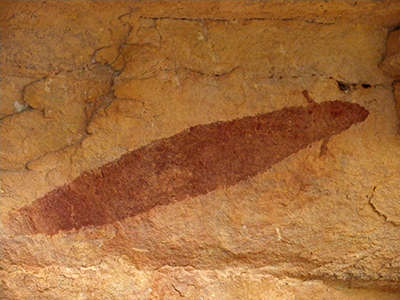
Eel-tailed catfish. The barbels, or whiskers, can be seen in the left hand image.
Photo: © Leo Dubal
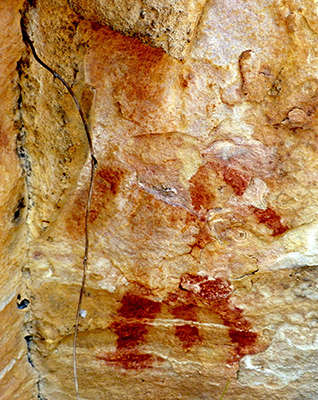
A very old male figure, in red ochre.
Photo: © Leo Dubal

Map of some of the sites mentioned.
Photo: supplied by Leo Dubal
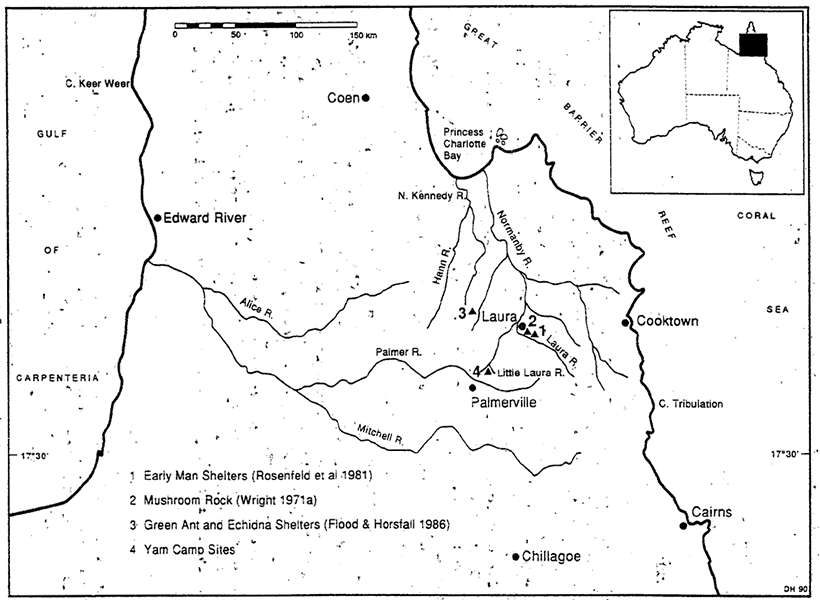
Map of part of Far North Queensland showing the location of the Laura River rock art sites.
Photo: Pearson (1989)
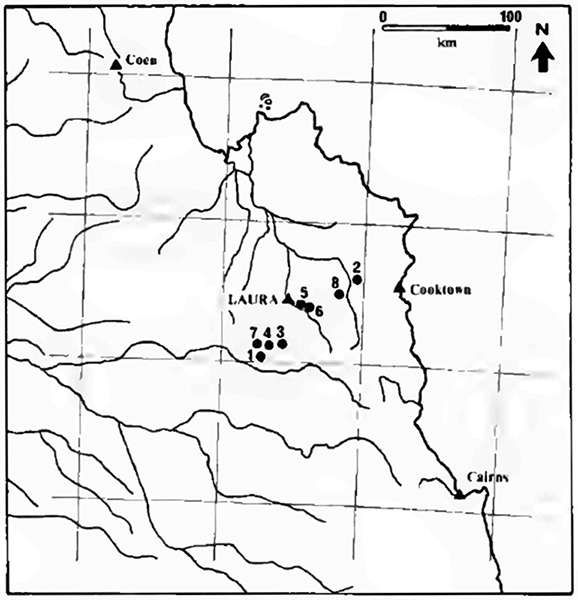
The Laura sandstone belt, showing the location
of some rock art sites.
1 Yam Camp
2 Platform Gallery
3 Magnificent Gallery
4 Sandy Creek
5 Mushroom Rock
6 Early Man
7 Red Bluff
8 Red Horse
Photo and text: David and Chant (1995)
References
- David B., Chant D., 1995: Rock art and regionalisation in north Queensland prehistory, Memoirs of the Queensland Museum, Brisbane 1 August 1995 Volume 37 Part 2 Hamlyn-Harris, Ronald; Queensland Museum
- Harding P., 2002: Outback Australia, Lonely Planet Regional Guides, 2002 - Australia - 496 pp.
- Pearson W., 1989: A Technological Analysis of Stone Artefacts from Yam Camp Surface Scatter and Rockshelter, S.E- Cape York Peninsula, Queensland Archaeological Research, Vol. 6, December 1989
- Sowerby J., Lear E., 1872: Tortoises, terrapins, and turtles drawn from life, London, Paris, and Frankfort, H. Sotheran, J. Baer & co.
